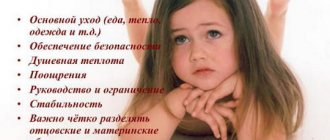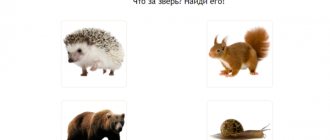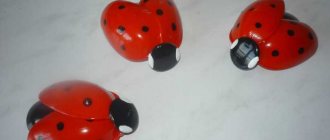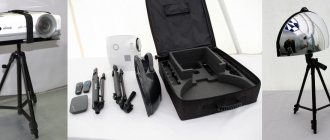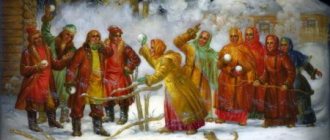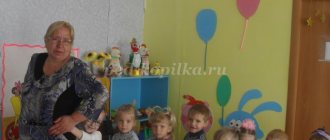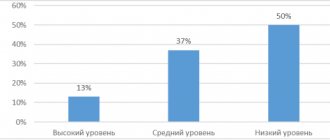Using problematic situations in environmental education of preschool children
Bibliographic description:
Ayvazyan, A. G. The use of problematic situations in the environmental education of preschool children / A. G. Ayvazyan, O. V. Marshalkina, O. E. Pankratieva. — Text: direct // Questions of preschool pedagogy. — 2021. — No. 6 (16). — P. 18-20. — URL: https://moluch.ru/th/1/archive/103/3693/ (access date: 12/19/2021).
This article is devoted to the topic of environmental education and its role in the preschool education system. In the modern world, the issue of the state of the natural world is quite relevant. The article addresses the following questions: “What are problem situations and how to use them in working with preschoolers”; “How to increase children’s cognitive activity”; “What to look for when organizing environmental activities on an eco-trail.”
Key words: preschool children, ecology, environmental education, problem situations.
The Federal State Educational Standard for Preschool Education proclaims the main goal of teachers to be the formation of an integral spiritual and moral personality. In modern realities, the concept of morality and spiritual culture of a person includes not only moral values, but also a certain level of environmental culture. The formed ecological culture of a preschooler is expressed in solid knowledge about nature, a caring and emotionally charged attitude towards it, an instilled healthy lifestyle, and the ability to understand the phenomena of the surrounding world.
The purposeful expansion of knowledge, skills and abilities of practical interaction with nature is the basis of environmental education and upbringing of children, which means the education of a humane and intellectual attitude towards nature (i.e. the formation of a system of environmental knowledge and ideas), spirituality, the development of aesthetic feelings (i.e. e. empathy for the beauty of nature). At the same time, the tasks of developing empirical and theoretical thinking and cognitive activity are solved, and the foundations of conscious interaction with the world are laid. Therefore, it is in preschool age that it is important to create conditions for children to develop an understanding that everything in nature is interconnected [1].
One of the most productive pedagogical technologies in preschool education is the technology of problem-based learning. The purpose of this technology in preschool educational institutions is to develop the ability to independently analyze a problem situation and find the correct answer. A necessary condition for the implementation of this technology is the presence of a problem situation, which implies a state of mental difficulty in children caused by the insufficiency of their previously acquired knowledge and methods of activity to solve a cognitive problem. At the heart of any problematic situation there must be a contradiction. According to the famous Soviet psychologist S. L. Rubinstein, thinking begins with the contradiction that has arisen.
There are four levels of learning problems:
‒ the teacher identifies the problem (task) and resolves it himself with active listening and discussion by the children.
- the problem is identified by the teacher, but the students themselves resolve it independently or under the guidance of an adult. The role of the teacher is to guide the student to find ways to solve the problem (partial search method).
- the child poses the problem himself, the teacher provides assistance in resolving it. At this stage, the ability to independently formulate a problem is formed.
- the student himself identifies the problem and independently looks for solutions.
The technology of problem-based learning can be used in different directions and at different moments. Regarding environmental education, it is advisable to use this approach in the following situations:
- During activities on the ecological trail. An ecological trail is a special educational route in natural conditions where there are environmentally significant natural objects. Along the route, children become acquainted with natural objects, the diversity of the living natural world and the interdependence of its objects. The educational and educational process on the ecological trail takes place in the form of relaxed communication directly in the natural environment. The use of problematic situations along the route allows you to reinforce the norms and rules of behavior in nature. For example, you can work out the following situations:
- The children picked a large bouquet of flowers for the teacher, but he was not happy, but upset. Why?
- In front of you is a berry meadow. There are a lot of berries, but you have little time. Maybe it’s worth picking the berries not one at a time, but just breaking the branches?
If there is a “pharmacy garden” along the route of the ecological trail, you can role-play a situation when a character is injured and there is no first aid kit nearby.
Also on the trail you can practice skills in participating in environmental activities and working in nature. For example, the situation with trees whose branches were broken by someone. Or a lesson on the topic “Soil” can be worked out using a problem situation like this: “Anya planted flowers, but they don’t grow at all and look bad. What could be the reason?".
- In a corner of wildlife, you can practice plant care skills with the help of problem-search situations. For example, a situation where two children took turns watering the same indoor flower and “gave it too much water.” The teacher’s task in this case is to prompt children to think about how they can save the plant (“dry it out”) and how this task can be realized.
- However, the most productive use of problem-based learning will be in experimental activities . During this activity, students not only learn to put forward hypotheses, make observations, analyze the information received and draw conclusions, but also make their own “scientific discoveries.”
The goal of experimental activities in preschool educational institutions is to form and expand students’ ideas about the world around them through practical independent knowledge. Such activities can be either basic, organized in a special subject-spatial environment (researcher’s corner, experimentation center, etc.), or accompanying, during classes, on walks, thematic leisure time or during independent activities.
To implement this activity, the teacher must fulfill a number of conditions:
‒ prepare a card index of problem-search situations of environmental content for preschoolers;
‒ provide an environment for students to independently study the properties and qualities of living and inanimate objects of the surrounding world;
- promote the organization of search and research activities, during which preschoolers independently (or together with an adult) find ways to solve problem situations that have arisen.
Children's experimentation is in many ways similar to scientific experimentation; children experience positive emotions from the feeling of the importance of the work done, obtaining visible results, and new information.
As part of experimental activities, the following types of classes can be conducted:
‒ Experimental games. A fairy-tale character is involved in the activity and asks for help in a problematic situation. For example, a Hedgehog appears in the group and complains that he just can’t arrange a hole for himself to sleep in - the pine cones are too hard, the spruce needles are prickly, etc. It’s time for him to go to bed, but he just can’t get comfortable. It is possible to create a game situation where children will act in imaginary conditions (the kingdom of the Snow Queen, visiting the Fairy of the Air, etc.)
‒ Modeling. Building models of natural objects allows us to gain knowledge about the properties of these objects, especially if these objects cannot be studied in direct contact. The reason for building and studying a model can also be a problem situation and its resolution.
‒ Conducting experiments. Conducting experiments allows us to visually explain physical phenomena in classes about the world around us. You can also lead to the experiment through a problematic situation. For example, the story of Pinocchio, who was in a hurry to go to school, but on his way he encountered a wide river, which he was afraid to cross so as not to drown. Experimentally, using containers with water and wooden toys, children establish that the tree does not sink, and accordingly, the wooden Pinocchio can safely swim across the river.
As a rule, problem situations should be well planned, with material prepared in advance, but at the same time involve a fairly flexible scenario. However, everyday situations can also be used as problematic, while updating everyday life in the group.
There are certain requirements for problematic educational situations:
- The solution to the problem situation proposed by the teacher should be aimed at nurturing independence and developing creativity in students.
- The solution to the problem should be in the child’s immediate development zone.
- When posing a problem, it is necessary to maintain a balance between the difficulty created in solving it and the degree of difficulty corresponding to the capabilities of the students in order to maintain stable motivation and the need to resolve the problem situation.
- The problem situation should be formulated as clearly and understandably as possible.
- The problem situation should be based on the basic didactic principles of teaching (scientific, systematic).
Stages of working with problematic situations in the educational process:
- setting, formulating the problem;
- updating children's knowledge;
- putting forward hypotheses and assumptions;
- selection, verification of solutions, justification of hypotheses;
- introduction of knowledge into the system.
To effectively use the problem-based method, it is necessary to separate the activities of the teacher and the activities of the student.
Activities of the teacher: creating a problem situation, formulating the problem, managing the search activities of children, summing up.
Student activities: “acceptance” of a problem situation, formulation of the problem, independent search, summing up.
Fundamental is the transition from generalized environmental knowledge to individualized [2], which implies the child’s ability to use new patterns of behavior, and also affects the development of his abilities for analysis and reflection.
In the process of solving problem-search situations, children form not only intellectual impressions, but also develop the ability to work in a team and independently, defend their own point of view, prove its correctness, determine the reasons for the failure of experimental activities, and draw basic conclusions.
In problem-based learning, the child is systematically involved in the search for solutions to new questions and situations that cause intellectual difficulty, where he develops mobility and variability of thinking, and intensifies mental activity.
Literature:
- Voroshilova V.V., Baglaeva Yu.P. Didactic game as a means of developing cognitive thinking in preschoolers in the process of environmental education [Text] / V.V. Voroshilova, Yu.P. Baglaeva // Pedagogical education. - 2009. - No. 2. - P. 13–29.
- Zolotareva O. V., Aronova E. Yu. Environmental education of preschool children in joint creative research activities with the teacher / O. V. Zolotareva, E. Yu. Aronova // Education and training of young children: materials annually. international scientific-practical Conf., 2021, Moscow / Mosaic Synthesis LLC. - M., 2021. - pp. 625–626.
- Mikheeva E. V. Ecological and subcultural practices in the environmental education of preschool children [Text] / E. V. Mikheeva // News of the Volgograd State Pedagogical University, 2009. - pp. 148–149.
Key terms
(automatically generated)
: problem situation, situation, the world around us, problem-based learning, ecological trail, preschool education, experimental activities, child, preschool age, environmental education.
System of work on education of ecological culture of preschool children
Forms of environmental education
Classes
The main form of environmental education in kindergarten is an activity. On them, children’s intuitive ideas are transformed, deepened, and expanded. The process of environmental education of preschoolers takes place in several types of classes:
- During the initial orientation classes, children get acquainted with plants and animals, their habitat and growth, and living conditions. This refers to those objects of nature that cannot be observed around you. The teacher talks about plants and animals, shows their appearance, introduces them to the manners, habits of animals, and the characteristics of plant growth. Paintings, videos, conversation, reading excerpts from works of art, for example, stories by V. Bianchi, are used as visual aids. Introductory classes are held in all groups.
- In-depth cognitive classes are designed to form preschoolers' understanding of the connections between plants and animals, the relationship between plant growth and the weather conditions of a certain area, the dependence of animals on environmental factors, the adaptability of animals, reptiles, and birds to natural conditions. The means of visualization here can be demonstration of models of natural complexes, targeted conversation, and primitive experiments.
- In general-type classes, knowledge is systematized, a unified picture of a particular natural environment is formed, conclusions are drawn about the relationship of flora and fauna, climatic conditions, and soil. For example, general lessons on the topics “Autumn”, “Winter”, “Spring”, “Summer”.
- Classes of a complex nature are based on the interaction of different types of activities: creative, gaming, artistic. They often extend beyond one activity. Alternating between playing and drawing, reading and watching does not tire preschoolers. If this happens, physical exercises or physical exercises come to the rescue.
Excursions
This is one of the most interesting forms of work. The advantage of the excursion is that preschoolers can directly contemplate the inhabitants of a zoo, park, meadow, or square. They can listen to birds singing, smell flowers, stroke animals and reptiles, examine their appearance, observe their behavior and nutrition. These are nature excursions.
You can take your children on excursions to agricultural enterprises: greenhouses, orchards, greenhouses, vegetable gardens. Such trips are organized to get acquainted with the work of people at different enterprises. Conducting excursions requires a lot of preparation: the teacher needs to familiarize himself with the method of conducting it, think through the main stages, types of activities, techniques that may be of interest to preschool children.
Search activity
Primary search activities are organized for older preschoolers. In the course of joint work, a problematic question is formulated that requires searching for an answer: why do birds fly south? Why is the snow melting? Why are the leaves falling?
The search activity represents either a heuristic conversation, an observation, or an experiment.
Methods and techniques of environmental education
The methodology of environmental education for preschool children involves 3 groups of methods:
- Visual: looking at pictures, modeling, watching films, observations.
- Practical: games, experiments, physical labor.
- Verbal: story, reading.
Visual methods
The formation of adequate ideas about the environment is possible by using visual aids in the classroom. Keeping weather calendars, getting acquainted with the paintings of famous landscape artists, watching documentaries about forests, meadows, and mountains expands and deepens preschoolers’ understanding of nature, and consolidates knowledge about the interaction of representatives of living and inanimate nature.
Observation makes it possible to understand the relationship between animals and plants, their adaptability to the conditions of the natural environment. It develops imaginative thinking and increases interest in observed objects. Examples of topics in the younger group: acquaintance with the bird, its appearance, its feeding, behavior; in the older group: the bird’s living conditions, its hearing, rest, sleep.
Modeling models of a forest, meadow, lake, field can become a common project for children, teachers and parents. Joint activities will strengthen the positive outlook of project participants.
Practical methods
In older preschool age, children begin to show curiosity, and in this period such practical methods as primitive experience and experiment are effective.
It is interesting to conduct small experiments with water, sand, clay, stone. All these materials make up the natural landscape. Teachers suggest freezing water, giving it different colors, comparing the strength of wood and stone, and watching how sand and clay pass water. These are small experiments that arouse the interest of a five-year-old child.
Verbal methods
Here everything depends on the teacher’s ability to talk interestingly about the life of plants and animals. Diction, intonation, and tone of voice also play a big role in awakening children’s interest in the life around them. The story may be accompanied by a conversation between the teacher and the children.
Reading passages from educational and fiction literature develops the imagination, enhances mental activity, generates curiosity, gives rise to curiosity, and a desire to understand the natural world.
